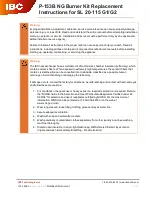
Solo Plus Instructions 1-800-782-9927 Version 12-13
Tarm Biomass · 4 Britton Lane · Lyme, NH 03768
4.12 Primary Air Adjustment
The primary air should be set to open fully when the draft fan is running. The stop
(B)
should not
touch the adjustment bolt
(A)
when the damper is the open position. However, if are regularly seeing
temperatures at the flue collar of the boiler of over 600 °F (315 °C) when the boiler is clean, we sug-
gest decreasing the primary air to lower the flue temperature. Adjust the stop in front of the draft fan
under the top front jacket panel. Loosen the locking nut and turn the bolt
(A)
in for less primary air
lowering the flue temperature to approximately 600 °F (315 °C). Tighten the locking nut when ad-
justed properly.
4.13 Secondary Air Adjustment
The primary air coming through the holes behind the loading door
(C)
and the total quantity of air nor-
mally should not have to be changed if the boiler is kept clean.
Correct secondary air adjustment is essential for optimum combustion and efficiency. Adjustment is
by means of the bakelite knob on the front of the boiler next to the top left corner of the ash door (see
diagram at top of page 40). To adjust, pull the knob down and slide left (more air) or right (less air).
The drier the wood is, the more secondary air required.
After approximately 45 minutes of operation with a load of wood, the boiler and refractory should be
heated. Observe the flame through the observation port or open the lower door carefully
while the
fan is still running
. Adjust the secondary air as needed. Once the proper adjustment has been set, it
should only be necessary to re-adjust when changing the type or quality of fuel. Use diagrams in
Fig.
4.5
as a guide to help in setting the secondary air.
The basic rules for setting the secondary air are as follows: If the wood is dry, add more secondary air.
If the wood is greener, use less secondary air. To have the knob in the center, usually covers most
situations.
Boiler Operation, Maintenance, and Service > Primary Air Adjustment
Page 42
A
B
Fig 4.2
Primary Air Adjustment
C
Fig 4.3 Primary Air Ducts (Holes)
Fig 4.4 Secondary Air Adjustment
















































